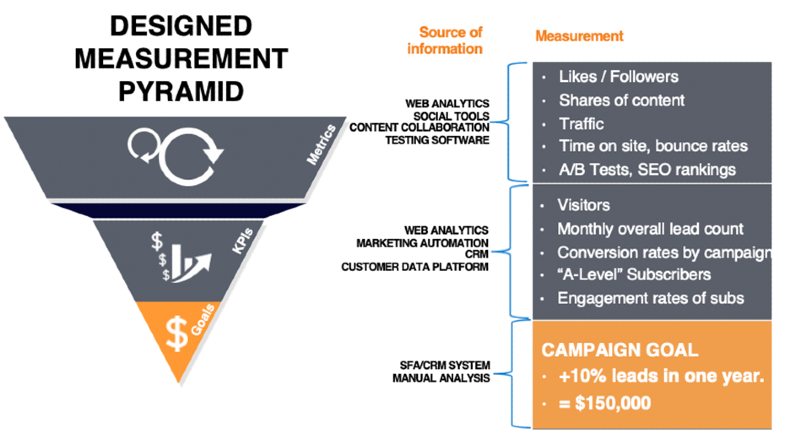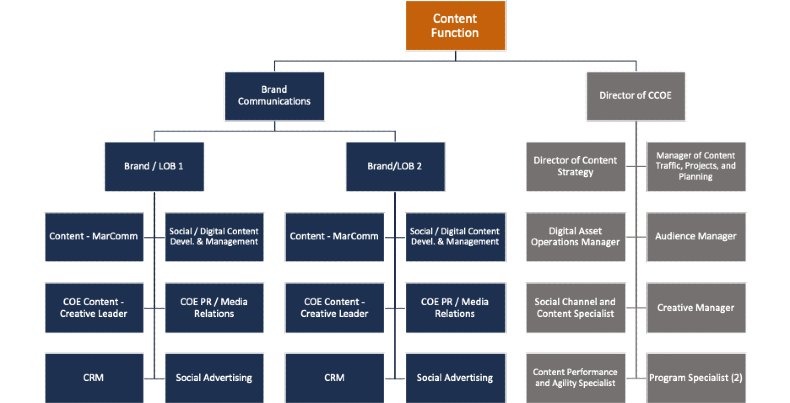"Yay!" said no one ever when contemplating significant change. But significant change is what we're advising when we say marketers should focus on content operations rather than content marketing only.
Content operations is the big-picture view of everything content-related within your organization, from content strategy to content creation, content governance, content-effectiveness measurement, and content management.
We frequently hear that content operations isn't necessary—that everything will work fine without it. But it won't.
Without content operations, there is content chaos. And you'll suffer huge opportunity costs.
The financial return on harmonizing content messaging across your organization can be tremendous. So here are 10 steps for achieving content operations maturity.
Step 1: Articulate your content team purpose
Perhaps your team's purpose is to deliver content to internal line-of-business teams, such as Sales, Marketing, and Corporate Communications. Perhaps it's to deliver content to external customers. Whatever the purpose, it must support your corporate objectives. If you haven't yet aligned your strategy and road map with corporate goals, you should do that before following these steps.
Step 2: Define your content mission
Is your content's mission to attract new recruits, build brand advocacy, deepen relationships with customers? And do you have buy-in from the organization—particularly the C-suite?
Can you talk about your mission with clarity? Have you created a unique voice or value proposition that every company should have?
All those questions need answers if you want to solidify your content mission.
Step 3: Measure, measure, measure
Content assets are called assets for a reason: They possess real value and contribute to the profitability of your business. Accordingly, you need to measure their efficacy.
There are three levels of measurement:
- Goals are quantifiable targets for content effort, whether 10% market share growth or 25% increase in sales. Goals are where the money is.
- Key performance indicators (KPIs) inform your progress toward your goals; they tell you whether the needle is moving in the right direction. Do you see growing numbers of visitors to your website? Fewer abandoned carts in your online store?
- Metrics are the hard numbers you're going to look at to determine KPI trends. The amount of "likes," "follows," shared content, and traffic are all metrics.

Step 4: Choose your approach
Your approach is how you organize your team and how it fits into the larger organization. We've identified three different approaches to content operations:
- The Rebel approach is for people with an entrepreneurial, startup mentality, and it's typically found in companies with individual divisions, products, and regions. If you're a rebel, you're agile and you work autonomously in smaller groups, which works well when you have multiple brands with no overlap.
Downsides include a lack of shared best-practices and resources. Content, people, expertise, technology—there's a lot of costly duplication of effort. - The Center of excellence (COE) is a centralized team that operates apart from the lines of business but still exerts control over all content, enterprisewide. This approach is highly focused on editorial messaging, with clear missions and responsibilities. You're bound to get excellent adherence to brand and to consistency of voice.
Scaling is hard, however. If not executed efficiently, the COE can become another silo or roadblock. - A Hybrid approach is the best of both worlds. You create an integrated network of content operations professionals that spans the organization. These professionals are embedded in the lines of business. They create and manage content specific to their organization's specific needs, but they tap into a centralized COE for common content needs, for guidance on content messaging and standards, and for collaboration on integrated content that's customized at the line-of-business level.
Step 5: Perform a skills audit
Assess what resources are available to you. That mostly means your people. What skills do they possess? Do those skills match what you need?
It sounds simple and straightforward, but it can be truly revealing to do an audit. Because you're not just asking people what they do but what they can do. You find hidden treasure: great speakers who have never used their skills for the organization's benefit, and creative people no one knew about.
During your audit, take note of the gaps in your skills portfolio, and then make plans to fill them.
Step 6: Organize your content operations team
Now that you've identified what approach you will take (rebel, COE, or hybrid) and the skills you need, you'll put your content operations team in order. What is the structure going to look like? Who's going to report to whom?
Here's a sample organizational chart we developed for a Fortune 50 firm.

Step 7: Train your team
Establishing a content operation can't be done in a vacuum: It's a journey, and you must take your team with you.
Training should cover three areas: your content strategy, the impact of that strategy on the customer experience, and data for optimizing content effectiveness. And training is an ongoing process, not a one-and-done thing.
Step 8: Put formal governance in place
Governance will ensure your content organization is following agreed-upon goals, objectives, and standards. And governance can be sexy! No kidding. We've seen magic happen.
First, get a senior-management advocate—ideally someone from the C-suite—to preside over the setting up of your governance structure. That's the only way you will get recognition—and budget.
Then create an editorial board. It should contain representation from all the functional groups in the business that make use of content, each of which will provide you with input as well as oversight.
The content operations team does its part, of course, to ensure content guidelines are adhered to and quality remains high. You'll put processes in place at strategic points in content workflow to examine content for tone, messaging, and overall fit for your corporate goals.
There's a tendency to focus on getting the content out and saying you'll figure out governance later. But the companies that invest in governance structures experience real impact—such as double-digit growth in content efficacy. Companies gain efficiency and effectiveness. They stop creating the same content over and over again. Quality goes up. Budgets increase.
Step 9: Create efficient processes and workflows
We encourage you to get a master line of sight into all content processes. How is content generated, from start to finish? You may find 27 ways of doing it, but your goal is to have 70% or more of your content—whether infographic, advertisement, or a speech for the CEO—created the same way.
As for reuse of content, look at the big picture—not just what's needed now but also what you'll require later. As you're interviewing subject-matter experts (SMEs), ask questions for all the pieces coming down the road. That way, your SMEs don't get fatigued.
Step 10: Deploy the right technology
Technology doesn't have to be fancy. An Excel spreadsheet is one of the most important tools you can use. The goal is to make your life easier, and to simplify.
How many tools are you using? Many organizations grow through acquisition, and so they inherit duplicate components within their content stacks. They might have two or three content management systems (CMSs) and several marketing automation platforms. See where you can streamline.
Identify how you can automate. For example, if you have a campaign that you run the first Monday of every month, deploy technology that allows you to automate that process.
* * *
Adopting a robust content operations framework requires both cultural and organizational changes. It requires sponsorship from the very top of the organization and adherence to corporate goals at all levels of the organization. None of it is easy. But the payoff is more than worth it.





